In 2025, digital privacy is no longer a distant concern reserved for cybersecurity professionals or conspiracy theorists. It has become a mainstream issue affecting almost every individual connected to the internet. Whether you are scrolling through social media, ordering food online, using a smart home device, or logging into your work computer, your digital footprint is growing. And according to industry experts, it is increasingly vulnerable.
While the world benefits from advancements in artificial intelligence, personalized experiences, and interconnected platforms, the cost is often overlooked. Our personal data, preferences, location, health metrics, and even emotional patterns are being tracked and stored, often without our clear knowledge or informed consent.
This article breaks down the current state of digital privacy in 2025, highlights the growing risks, and brings in expert analysis on what this means for individuals and society at large.
The Evolution of Privacy: From Passwords to Profiling
Digital privacy used to mean using strong passwords and enabling two-factor authentication. Today, that is only a small part of a much larger and more complex picture. The conversation has shifted from simply protecting account access to managing entire digital identities.
Tech companies now gather vast amounts of data not just on what users do, but how they do it. Behavioral patterns, facial expressions, voice tone, eye movements, sleep habits, and even medical signals are being analyzed and monetized. As more apps and devices integrate AI and biometric technology, these data streams become even more granular and powerful.
The evolution from passive tracking to active profiling has intensified the risk. Experts argue that we are entering an era where companies know us better than we know ourselves — and this knowledge is being used to influence decisions, emotions, and behaviors.
Key Threats to Digital Privacy in 2025
Experts across fields have pointed to several emerging threats that are accelerating privacy risks in the current year. These are not abstract concepts; they are present in devices and platforms used every day.
1. AI-Driven Surveillance
Artificial intelligence has enabled powerful new surveillance tools. Cameras powered by machine learning can now recognize faces in crowds, detect emotion, and follow individuals across city blocks. Governments and private companies are adopting these tools for security, marketing, and behavioral analytics.
In countries with minimal regulatory oversight, AI surveillance is being used to monitor citizens in real time. Even in regions with stronger laws, loopholes remain, allowing data to be collected under the guise of public safety or service optimization.
2. Biometric Data Collection
Devices like smartwatches, fitness trackers, and even smartphones collect biometric data such as heart rate, blood oxygen levels, and stress indicators. While these tools offer convenience and health benefits, experts warn that the data is often shared with third-party advertisers or insurers.
This raises troubling questions. Could your heart rate during a political debate be used to predict your beliefs? Could your stress levels be sold to pharmaceutical companies? In 2025, the answer is not science fiction — it is already happening.
3. Data Brokers and Shadow Profiles
Many internet users are unaware of how much information is held by data brokers — third-party companies that collect, trade, and sell personal data. These brokers build shadow profiles that include not just your public activity, but estimated income, political leanings, sexual orientation, and psychological profile.
These profiles are sold to marketers, employers, insurers, and other entities who use them to make decisions about pricing, job screening, and more. In many cases, individuals have no way to see or correct the data being used against them.
4. Smart Home Devices as Listening Tools
Devices like voice assistants, smart TVs, and home security systems often require access to microphones and cameras. While companies claim that data is only collected when activated, independent audits have revealed that some devices record ambient audio or store conversations longer than disclosed.
The convenience of controlling your lights or playing music with a voice command comes with the risk of having your private conversations analyzed, stored, or hacked.
Regulatory Gaps and Inadequate Protections
Despite growing concern, legislation has failed to keep pace with technology. While regions like the European Union have adopted frameworks like the General Data Protection Regulation, enforcement remains inconsistent. In many countries, privacy laws are outdated or nonexistent.
Experts point to several areas where regulation is lacking:
- Cross-border data transfers often occur without user consent
- Children’s data is collected through educational platforms and entertainment apps without adequate safeguards
- Health data privacy is threatened by partnerships between tech companies and healthcare providers
Even when laws exist, companies frequently circumvent them through vague consent forms, dark patterns, or excessive complexity. As one cybersecurity researcher put it, digital privacy in 2025 often depends more on a user’s patience to read terms and conditions than on robust legal protections.
Expert Perspectives: What Industry Leaders Are Saying
Several cybersecurity and privacy experts have weighed in on the state of digital privacy this year.Dr. Angela Reid, a data ethics professor, notes that the biggest threat is not hacking but normalization. “The erosion of privacy is happening quietly. People have accepted being watched because it is baked into convenience.”
Javier Ortega, a former software engineer turned privacy advocate, argues that the issue is systemic. “Big tech makes privacy a feature for those who can afford it. Free users pay with their data. The structure is tilted against the average citizen.”
Maya Chen, a cybersecurity analyst at a major think tank, emphasizes that surveillance capitalism has outpaced oversight. “There is no transparency in how models are trained, how biases are built in, or how deep these systems go. It is not just about targeted ads anymore. It is about manipulating emotion and perception.”
Steps You Can Take: Protecting Yourself in 2025
While structural change is slow, individuals can take meaningful steps to regain some control over their digital lives.
- Limit app permissions to only what is necessary for functionality
- Use privacy-focused browsers and search engines that do not track user behavior
- Avoid connecting unnecessary smart devices to your home network
- Regularly clear cookies and browsing data
- Use end-to-end encrypted messaging platforms
- Demand transparency from services and platforms you use
Experts also recommend pushing for legislative reform. Engaging in public discourse, supporting advocacy organizations, and voting for privacy-conscious policies can help shift the balance.
Conclusion:
Digital privacy in 2025 stands at a crossroads. The promises of innovation, convenience, and connectivity are undeniable. But they have come at a price — one that is increasingly paid in personal information, behavioral manipulation, and a loss of control over identity.
Experts agree that unless strong protections are put in place and transparency becomes the norm, the risks will only grow. What we do now — as users, policymakers, and innovators — will shape the future of privacy for generations.
The time for passive concern has passed. The fight for digital privacy is not just about protecting data. It is about defending dignity in the digital age.



